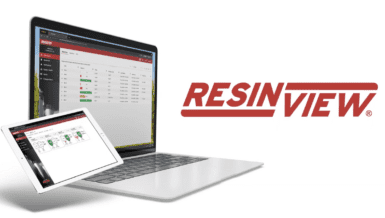SiloWeigh is a system for recording the inventory in silos by weight measurement.
We bolt the sensors onto the silo support structure during the installation of SiloWeigh. The sensors produce a measurable voltage that we convert to digital form. We display this as a series of bar-graphs for a number of vessels or a trend graph for a single vessel.
It enables a user to determine the best time for filling so that his company never runs out of material and never overfills a silo, which could create an environmental hazard. It also enables the user to measure each delivery and, although not legal for trade, detect shortages due to fraud. The L-Strain sensors have two legs; one measures the stress and the other compensates for the expansion of the structure. As a result, we can measure silo inventory in steel, stainless, and aluminum structures equally. The accuracy of the system depends on the stress in the supporting structure of the vessel; we have developed a spreadsheet to verify the stress and this is available on the scaletron.com website.
Background
You have, most likely, using a plastic cup or beer container without even noticing that it came from Jing Chye Enterprises Co. in Lukang, Taiwan. They are the world’s largest producer of plastic cups and beer glasses. We supplied the system comprising sixteen L-Strain sensors, digital transmitters for four silos, and one SiloWeigh II Pro touch-screen display unit (fig. 1) through our Taiwan dealer, Helio International, to Jing Chye in April 2018. The silos supply plastic pellets to the company’s injection molding process.

I arrived on-site in early May 2018 to train their staff, make training videos and supervise the installation of the SiloWeigh system. Our dealer was building the silos when I arrived, (fig. 2). They are of the bolt-together skirted type with internal H-beam strengtheners, onto which we bolted the sensors, (fig. 3).

Fig. 2. the four skirted silos being assembled at Jing Chye Enterprise Co. Ltd. in Taiwan. 
Fig. 3. An L-Strain sensor installed on the interior strengthening column of a skirted silo.
Once we had installed the sensors for the first silo, we connected them to the digital silo transmitter, (fig. 4). Each silo receives power from the SiloWeigh indicator and supplies the sensors with 5-volt excitation. The millivolt signals return to the transmitter and are converted to a digital RS485 4-channel signal. A multi-drop cable transmits this to the SiloWeigh indicator. The digital transmission method eliminates the need to run separate cables from each silo and allows long cable lengths that would not otherwise be possible. Alternatively, clients can transmit the data by VHF radio with a separate power source, or solar power when the silos are isolated. The SiloWeigh II Pro indicator utilizes a touch screen, programmed to display up to 6 silos. Clients can connect this to a computer on the local network, or to smartphones by WiFi. A viewing app shows the silo inventory screens or controls processes such as setup and calibration. For higher numbers of silos, SiloWeigh.Net, has a limit of 32 silos per location and connects to an Internet database. Users can view their company’s silos through any browser.

Fig. 4. The DJB500 transmits the digital signal for all silos to the display unit. 
Fig. 5. Filter performance showing a skirted silo with marginal stress, unfiltered (blue) and filtered (red) over one week of use.
SiloWeigh II Pro and SiloWeigh.Net weather filter
All bolt-on sensors suffer from errors due to weather; principally rapid temperature changes, which produce changes in output resulting from uneven stresses caused by the expansion of the structure. We at Scale-Tron have developed a very effective weather filter that removes these effects almost entirely. It leaves a series of readings that follow fast fills and discharges but ignore the sometimes large changes due to weather. Typically we can eliminate up to 98% of these effects to give an accuracy of 1 to 2% of capacity on legged silos and 2 to 5% on skirted silos. The operation of this filter can be seen in the SiloWeigh.Net trend-graph display, (fig. 5). The blue curve shows unfiltered readings, which would be the main display on competitors’ systems. The white curve shows the filtered result. This filter is available on both SiloWeigh II Pro and SiloWeigh.Net.
Silo Inventory, remote viewing and control
You can view the SiloWeigh.Net system by entering www.siloweigh.net in your browser, clicking Login, and entering username demo1 and password demo1. Click any silo to see the trend graph and scroll through historical data by clicking the links below the graph. The local computer gives us an opportunity to view it remotely and help with setup tasks. By use of LogMeIn or TeamViewer remote control software, we can modify the filter and other parameters. A useful tool that we have developed is the filtered spreadsheet. By pasting the client’s data into this we can tune the parameters to give the best results, subsequently setting the same parameters into the client’s system.
Our Taiwan dealer reports that the SiloWeigh installation was successful and the silos have been reporting steadily since their calibration in May 2018. They are presently installing SiloWeigh on a further 15 silos at Shuter Enterprise Co. Twelve of these are stacked, one on top of the other. SiloWeigh is now capable of viewing the inventory of divided silos, silos on a shared frame, and stacked silos. Our powerful weather filter works on all of them.














































